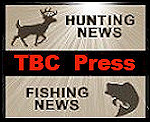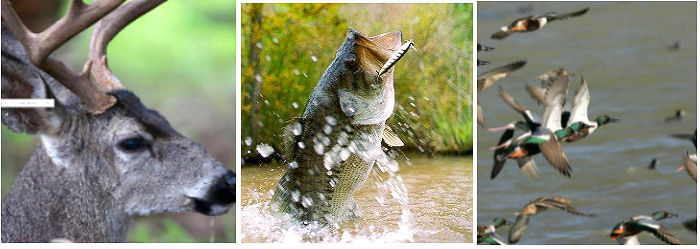The Backcountry Press
The country's premier daily HUNTING, FISHING & OUTDOOR news in the USA and around the globe. Read whats happening in your neck of the woods & beyond.
The Backcountry Outdoor News reports the latest hunting and, fishing news along with fishing derbies and tournaments
from:
| ||||||
| ||||||
|
Whether an event is for freshwater, saltwater, open water or ice fishing, they are listed in our directory.
HUNTING NEWS CATEGORIES
© 2010 Backcountry Press Outdoor News - All Rights Reserved Website Design by:
Connect With Us
 | ||||
Disclaimer: The views expressed on this site are that of the authors and not necessarily that of TBC Press
 | ||||
If you live in a big city and love to hunt and fish, it can be a struggle to find a place to pursue those passions and find success. Hooking into a hot bed of smallies or shooting a doe, few ducks or rabbits for the pot is more difficult in urban areas than the back 40.
But in many cases outdoor opportunities are abound right outside city limits, it’s just a matter of finding them. That’s where this list comes in. It will give you better options to find, and take advantage of, the public access closest to you.
Best Public Lands Near Big Cities
Submitted by: TBC Press
Posted on: 02/12/20
Article A20-2140
New York City
Best Public Option: New York City Department of Environmental Protection Watershed Lands
Best Species to Hunt/Fish: Whitetail deer, largemouth bass
Distance from City: 20 miles
Acres: 130,000
Fortunately for residents of the city that never sleeps, the New York City Department of Environmental Protection Watershed Lands offer deer, bear, turkey, and small game hunting opportunities a short drive from Gotham. This vast network of lands starts about 20 miles from Manhattan and stretches up through central New York. In addition to the appropriate state licenses, hunters must possess a free access permit to hunt or fish on designated areas on the City’s Water Supply Lands.
The plots closest to NYC in Westchester County are an urban bowhunter’s dream. The lands surrounding the Cross River, New Croton, Muscoot, Kensico, and Amawalk Reservoirs are broken into parcels of 200 to 300 deer-laden acres, offering easy access. Slightly further north in Putnam County, an abundance of whitetails and cooperative hunters have caused the NYC DEP to institute tenets of Quality Deer Management on some units, which ups the potential to produce giants. Hunters are encouraged to take does; the DEP will occasionally even make additional antlerless tags available through a lottery. On the first two days of bow, gun, and muzzleloader seasons in the QDM areas, only does may be harvested. On all other days, bucks may only be taken if they have an antler spread of at least 15 inches in width and/or a minimum of three points on a side greater than one inch long, excluding brow tines.
Dropping a boat will also require a free permit, which may involve a wait list of up to seven years depending on the waterway. The boat must be chained up alongside the reservoir. If you’re not willing to jump through these hoops, you can fish from rental canoes and kayaks on some reservoirs or get in on the action from the shore access sites. Kensico Reservoir, about 20 miles from the Big Apple, has a well-deserved reputation for producing monster largemouth bass. The state stocks about 8,000 brown trout every spring, which provide sport for anglers and forage for hungry bass.
Los Angeles
Best Public Option: Angeles National Forest
Best Species to Hunt/Fish: Mule, whitetail, blacktail deer
Distance from City: 26 miles
Acres: 694,187
It makes sense to have a combo hunt/fish license in your pocket if you head to the Angeles National Forest. Located about an hour outside of L.A., the forest, which encompasses the San Gabriel Mountain range, allows hunting in designated areas and an abundance of fishing opportunities. According to the California Department of Fish and Game (CDFG), there is plenty of public land with excellent access and the rivers and streams are stocked occasionally with bass and trout as part of CDFG’s stocking program. Some of the ANF’s best deer hunting can be found in San Gabriel Canyon, Glendora Ridge, Lake Castaic, Mt. Gleason or the Altadena area. Whitetail, mule and blacktail deer are all huntable. Remember, you can only use lead-free ammo in California.
Frenchman’s Flat Day Use Area is 2,200 acres and known for its native trout fishery. Other fishing options include Coldbrook campground, Fisherman’s Point on Little Rock Reservoir, Emigrant Landing and West Fork. There is typically a $5 per day fee to get access to these sites.
Houston
Best Public Option: Anahuac National Wildlife Refuge
Best Species to Hunt/Fish: Blue- and green-wing teal, mottled duck, gadwall, pintail and northern shoveler
Distance from City: 45 miles
Acres: 34,000
Coastal marsh and prairie add up to the perfect equation for quality waterfowl hunting in the Anahuac National Wildlife Refuge in southeast Texas. According to the U.S. Fish and Wildlife Service (USFWS), the refuge is home to a variety of wildlife, ranging from migratory birds to alligators, bobcats and more. But waterfowl hunting is one of its primary recreational uses. This is in part because of the management strategy in place for protecting nesting and breeding areas for waterfowl, shorebirds and waterbirds. Over 40 percent of the refuge is open to waterfowl hunting; however, you should contact the refuge headquarters before heading out for current regulations and permits. You must carry a free general permit when hunting on the refuge and a separate permit to hunt the East Unit, which cost $10 per day or $40 for an annual license.
You can also try fishing from one of three piers for a variety of freshwater fish like crappie, largemouth bass, alligator gar, bowfin, channel and blue catfish. Or, because of where the refuge is situated, you can also try saltwater fishing along the shorelines on East Galveston Bay for speckled trout, redfish, and southern flounder. Be aware that certain rules apply to boat usage in the refuge as well.
Chicago
Best Public Option: Des Plaines State Fish and Wildlife Area
Best Species to Hunt/Fish: Pheasant
Distance from City: 58 miles
Acres: 5,400
The lack of funding for state lands in Illinois has led to some tough times for public hunters. Most site managers work hard with what they have at their disposal, and the pheasant program at Des Plaines SFWA is a prime example. The upland fields are well-kept, and starting in late October through early January, the site is stocked with pheasants Wednesday-Sunday. Resident hunters pay $30 a day ($35 for non-resident) and are allowed a two-bird limit. You have to apply for a permit (or go on standby the morning of the hunt), which can be done through the Illinois Department of Natural Resources website.
Site manager Jeff Wepprecht suggests you apply for the permit because they release birds the night before based on the number of hunters expected. During the week, hunter numbers fluctuate between 50 to 100, but on weekends expect 175 to 215. A permit assures your group a field, so it’s smart to go that route. It also means more birds will be put out the night before. Hunting begins at 9 a.m. and closes at 4 p.m. You will be assigned a field, but after the first hour hunters are allowed to roam the entire upland unit.
Whitetail bow hunters are free to hunt everyday until the pheasant season begins. You just have to apply for a windshield tag (a simple process), which must be displayed when you park. Once the pheasant season is in, bow hunters are limited to Monday and Tuesday. Des Plaines also accommodates 35 hunters for the first three-day deer gun season. That is also done by permit through the IDNR site. There are 30 stakes on the Des Plaines River for duck hunting, which are drawn by lottery at the site the last weekend in July. You show up, put your name in the hat, and if it gets drawn, you have a blind for the season, which you must build (sometimes blinds are left over from the previous season, but don’t bank on it). Hunters must be in the blind 30 minutes prior to shooting light. After that, anyone can claim the blind.
Anglers can fish the Kankakee and Des Plaines River, plus there is a smaller 20-acre pond on the property. Most common species are catfish, walleye, bass, crappie and bluegill.














